
Driving in Norway – The Ultimate Road Trip Guide
Everything you need to know before driving in Norway: ferries, tunnels, mountain passes, and local tips that turn the road into part of the adventure.
Driving in Norway is not just about getting from one place to another – it’s a journey in itself. From dramatic fjords and endless tunnels to narrow mountain passes and ferries that act as floating highways, driving here is unlike anywhere else in the world. It can be breathtaking and sometimes challenging, but with the right preparation you’ll find it both safe and unforgettable.

Before you start driving in Norway
- Driver’s license: Most foreign licenses are valid. Check if you need an international driving permit.
- Rental car or campervan? A compact car is perfect for cities, while a motorhome gives you more freedom and the chance to wake up to fjord or mountain views.
- Insurance: Norwegian roads are safe, but nature is wild – rockfalls, animals, and narrow shoulders mean good insurance is essential.
- Pack for all seasons: Even in summer, weather can change dramatically. You might have 25–30°C by the fjords and close to freezing in the mountains the very same day. Always bring layers, a rain jacket, and sturdy shoes – you’ll thank yourself when the fog rolls in or a sudden summer snow shower hits.
- Plan your route: Distances look short on the map, but roads take longer than expected. Decide what highlights you don’t want to miss – like Trollstigen, the Atlantic Road, or a ferry through the fjords – and allow enough time. That way you’ll enjoy the drive instead of rushing past Norway’s best experiences.
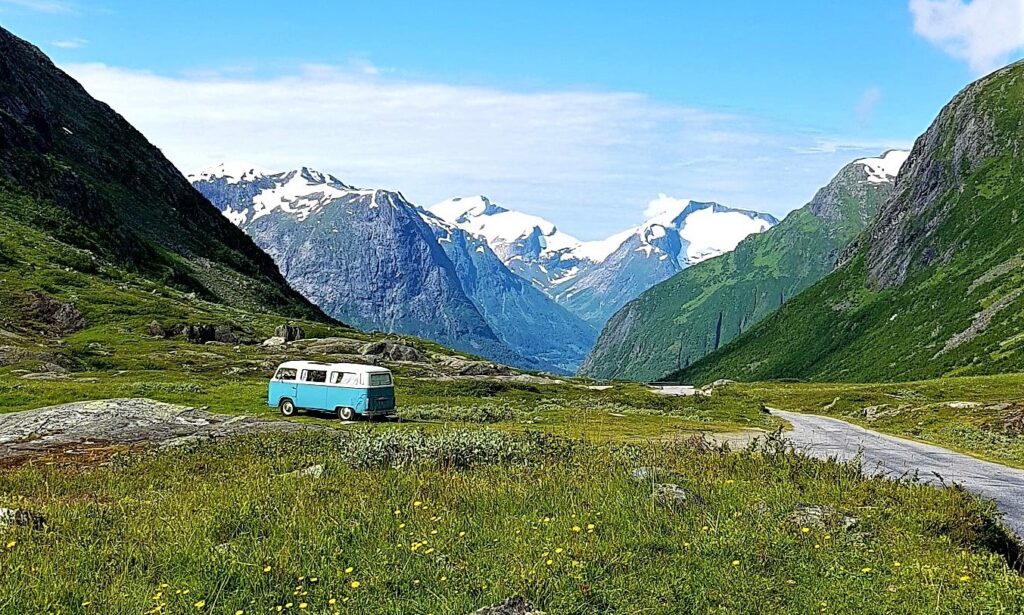
Did you know? 🗺️
On the map, Norway looks small – but the winding roads and countless fjords make travel times much longer than expected. A drive that looks like two hours on Google Maps can easily take four, especially if ferries are involved. That’s why locals always say: plan less, see more.
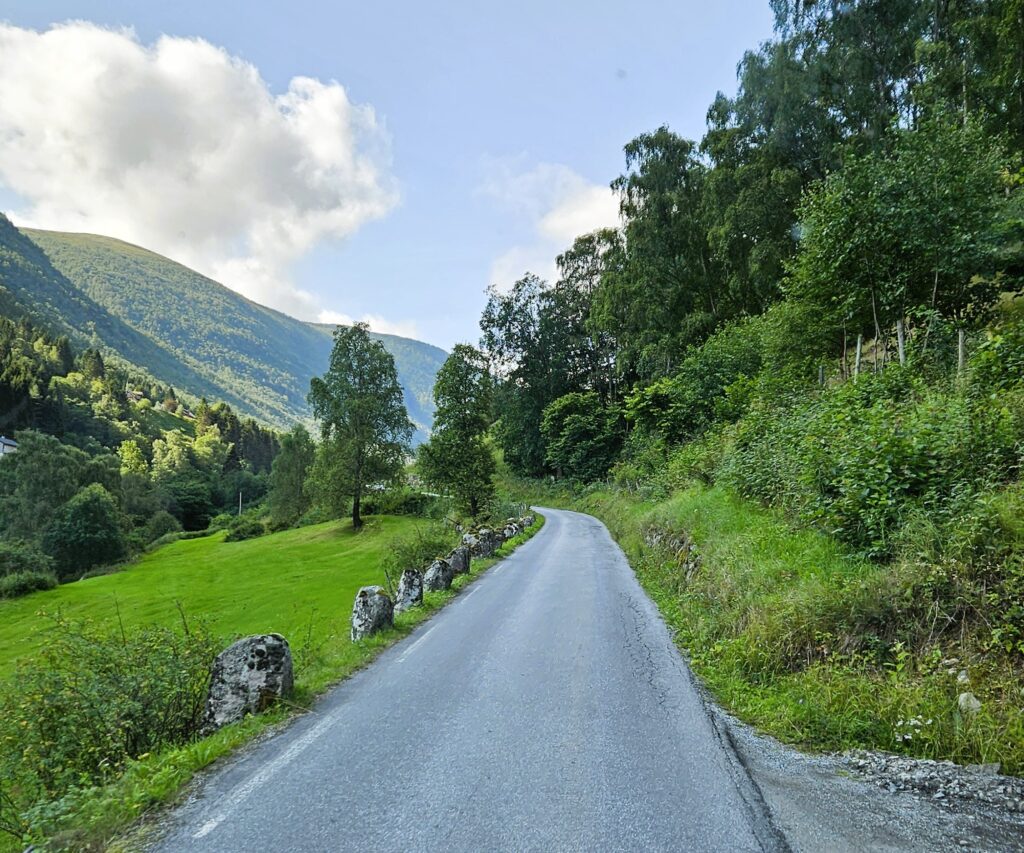
Driving rules and road etiquette in Norway
Speed limits
- 50 km/h in towns and villages
- 80 km/h on country roads
- 90–110 km/h on highways
But keep an eye on the signs: many country roads are limited to 60 or 70 km/h, especially in areas with sharp bends, scattered houses, or high accident risk. Locals stick to these limits, and speed cameras are common.
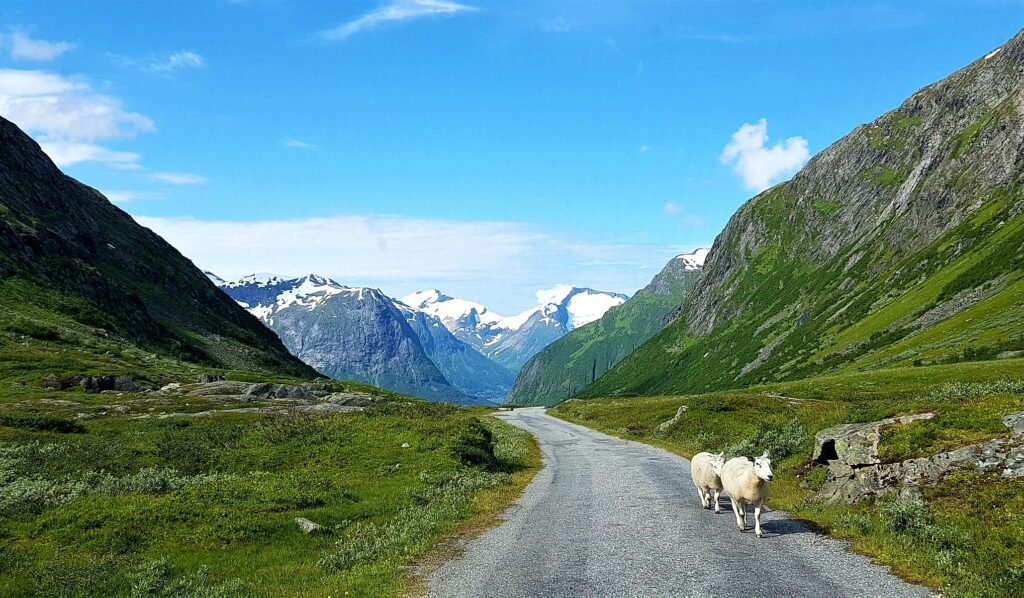
Other important rules
- Alcohol limit is 0.2 – practically zero tolerance.
- Always drive with headlights on, even at midday in summer.
- Mobile phone use only hands-free.
- Seatbelts are mandatory for all passengers – no exceptions.

Traffic culture
- Stick to the speed limit – fines are steep, and speed cameras are everywhere.
- Slow vehicles are expected to pull over in passing pockets.
- Always stop for pedestrians at crossings.
- The “right-hand rule” applies unless otherwise signed.
- Use the horn only in emergencies.
- Want to stop for photos? Always wait for a safe lay-by or pocket – never block the road.
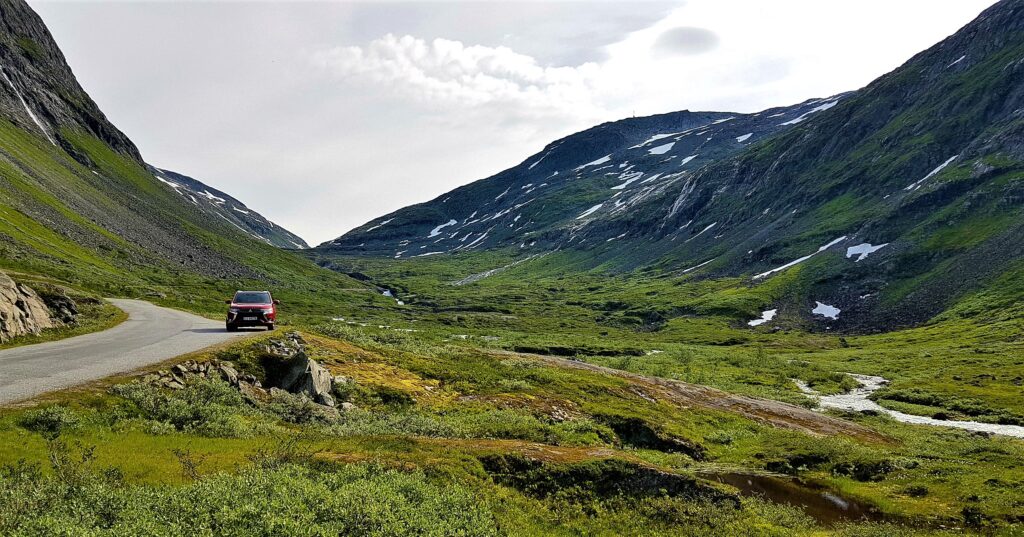
Did you know? 💸
Traffic fines in Norway are among the highest in Europe.
- Talking on a mobile phone without hands-free: around €1000 (10 450 NOK – 2025).
- Driving without a seatbelt: about €150 (1 500 NOK).
- Speeding can cost up to several thousand euros – and in serious cases, even your license.
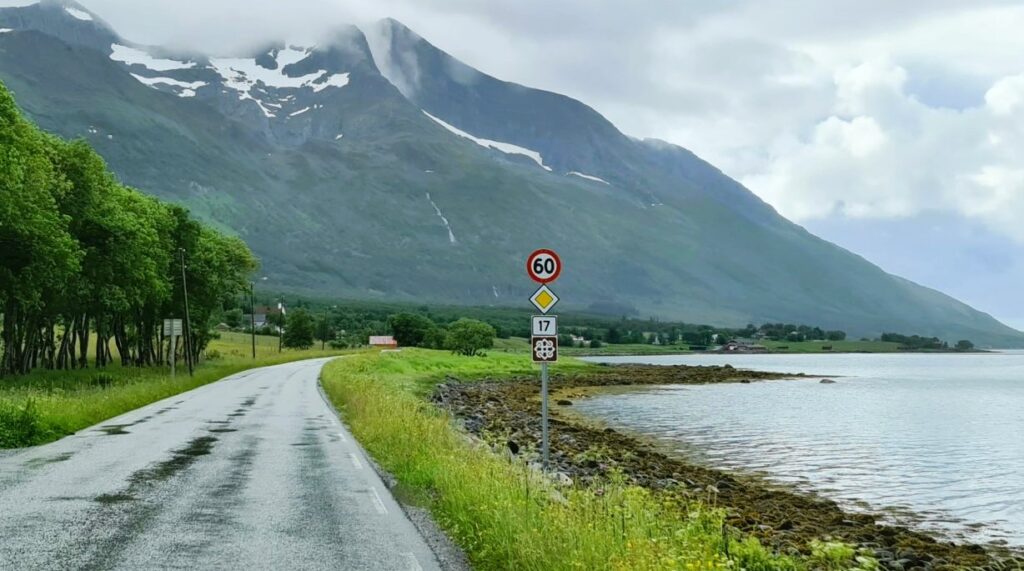
Road conditions and driving culture in Norway
Tunnels everywhere
Norway has more than 1,000 road tunnels, from short shortcuts through hillsides to the Lærdal Tunnel – the longest in the world at 24.5 km. Some tunnels are narrow or poorly lit, so remember to turn on your headlights and stay calm. And don’t forget to remove your sunglasses before driving in – it can go pitch black in an instant.
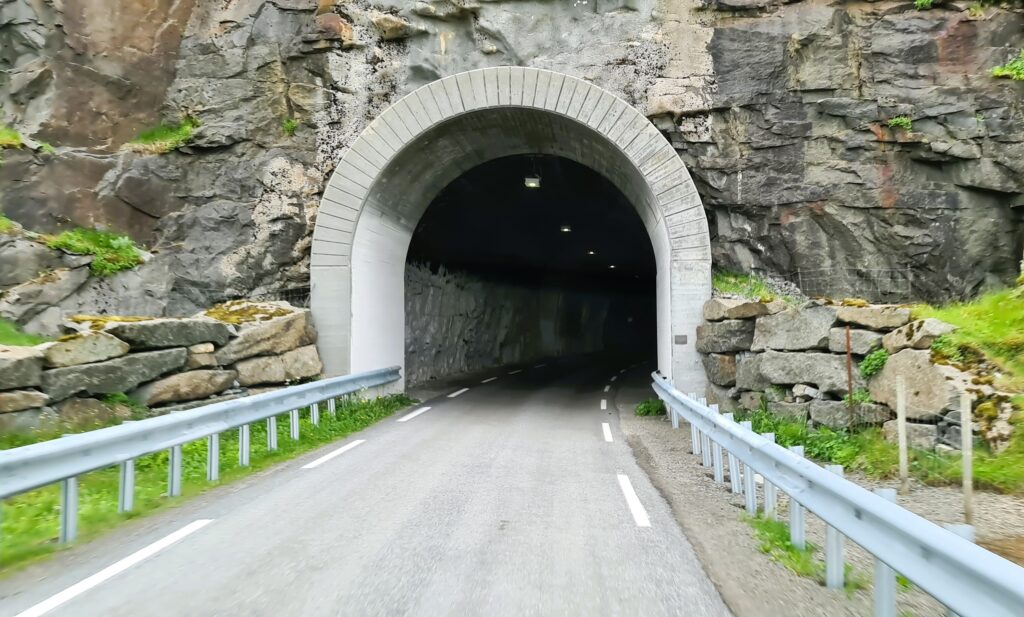
Rockfall and nature hazards
Along fjords and mountainsides, you’ll often see warning signs for rockfall areas. Drive carefully, reduce your speed, and be prepared for sudden obstacles on the road.
Animals on the road
All across Norway you’ll find warning signs for animals. It could be elk, deer, cows, sheep, or goats. They may appear suddenly – and rarely travel alone. If you see one, slow down, because more are likely to follow.

Drive according to conditions
Even if the sign says 80 km/h, that doesn’t always mean it’s safe to drive that fast. Many country roads are narrow, full of sharp bends, and have no shoulder. Locals will often drive well below the posted limit, especially in bad weather. The golden rule in Norway is simple: always drive according to conditions, not just the sign.
Local driving style
Norwegians are generally patient drivers. Overtaking is less common than in many countries, and honking is reserved for real emergencies. For most visitors, driving here feels calm and relaxed. But remember: locals live in this beautiful scenery, and many are simply commuting or heading to work. They want to get there quickly – not stop and enjoy the view. So be considerate and pull over if cars are lining up behind you.
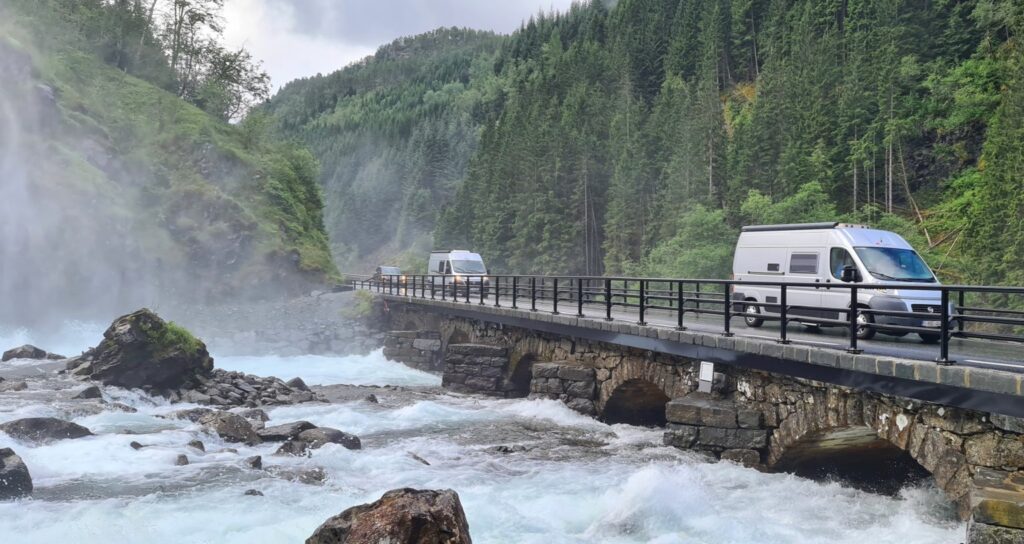
Did you know? 🚗
Norway has more road tunnels than any other country in the world – over 1,000 in total. The longest, the Lærdal Tunnel, even has three large caverns inside where drivers can stretch, rest their eyes from the monotony, and take photos.
Seasons and weather when driving in Norway
Winter
Snow, ice, and short daylight hours make winter driving in Norway a challenge. Winter tires are mandatory, and in mountain areas snow chains may also be required. Over the highest mountain passes there is often convoy driving (kolonnekjøring) behind a snowplow, and sometimes the road is completely closed due to heavy snowfall.
Winter driving tip
Always carry warm clothes, blankets, and some food and hot drinks in the car. If the road closes or you end up waiting in a convoy, you’ll stay safe and comfortable.
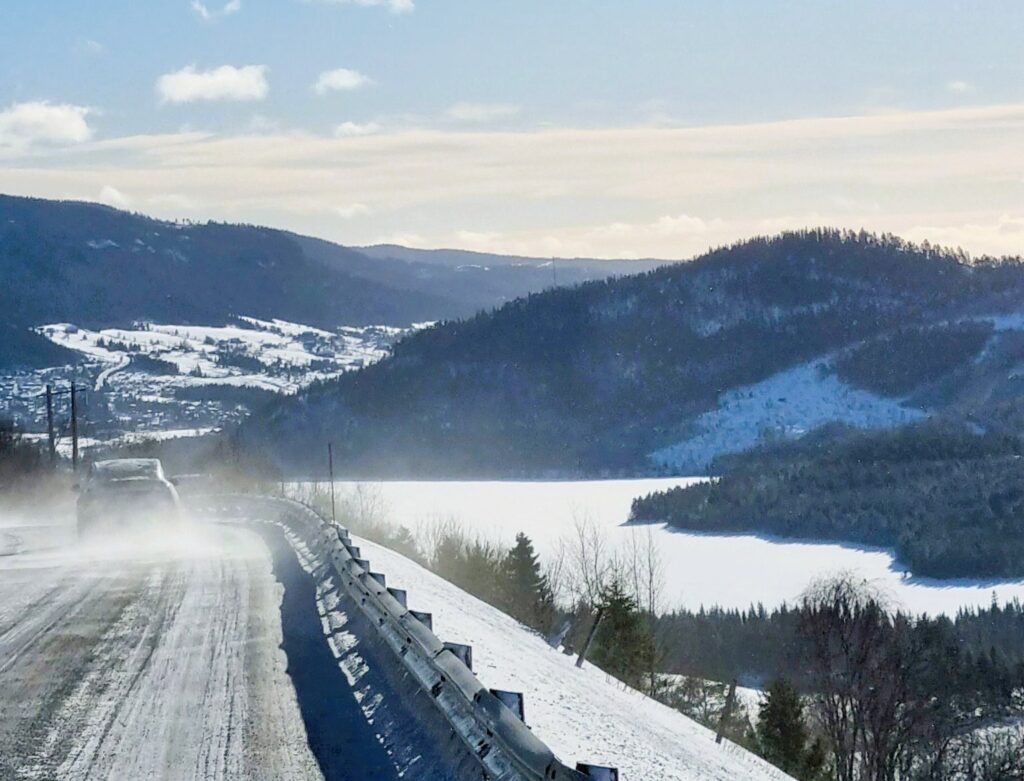
Spring
Weather in spring varies a lot depending on where you are. Along the southern coast, roads are usually snow-free from April, while in the inland and mountain areas snow can last until May – and occasionally even into summer at the very highest passes. In Northern Norway the weather is less predictable, but from April/May most main roads are clear of snow.
Spring driving tip
Don’t trust the calendar – check the forecast. In the mountains, snow can appear suddenly, even in May. Always keep a scraper and a small shovel in the car, just in case.
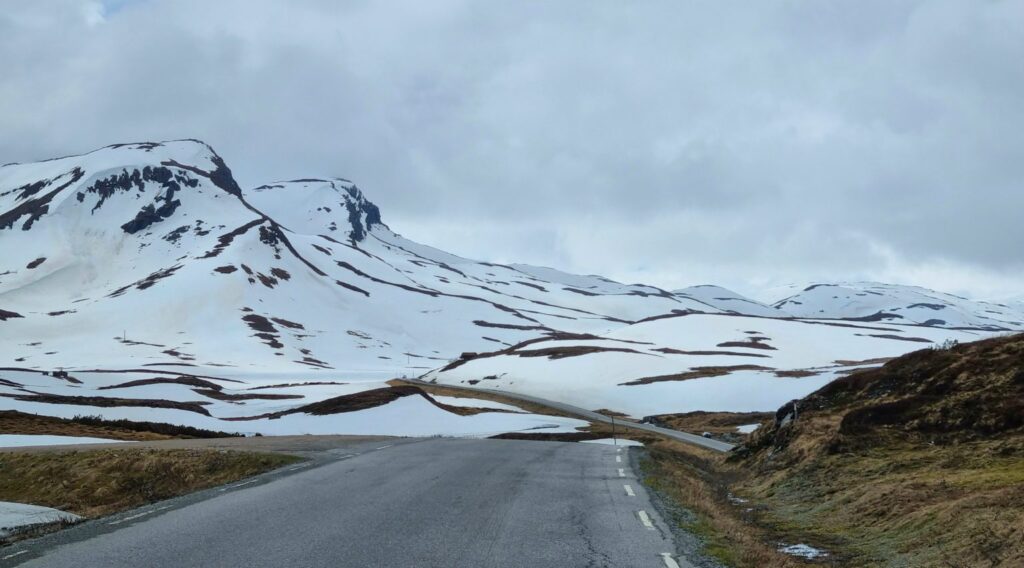
Summer
Summer brings long days and, in the far north, the midnight sun, meaning you can drive in daylight around the clock. But don’t be fooled by the season: in the mountains, the weather can change in minutes, with sudden fog, heavy rain, or even a brief snow shower. Temperatures can swing from 25–30°C in the fjords to close to freezing on mountain passes – all in the same day.
Summer driving tip
Bring layers of clothing. You can start the day in shorts by the fjord and end the day wearing a jacket and hat on a mountain pass. And never underestimate the fog – slow down immediately if visibility drops.

Autumn
Autumn is spectacular with colorful landscapes, but also the time of year when wildlife is most active. Elk and deer often appear on the roads, especially at dusk. If you’re planning to cross mountain passes, be aware that winter tires may already be necessary as early as October.
Autumn driving tip
Watch out for wildlife, especially at dawn and dusk. If you see an elk or deer, slow down – more are often right behind. And if you’re driving through mountain areas, consider putting on winter tires early.

Always check road conditions before setting off. Mountain passes can close suddenly due to snow, landslides, or strong winds – even outside of winter.
Did you know? ❄️
Norway has more than 40 official mountain passes that can be closed during winter – some even stay shut until late May or June. On the highest routes, like Sognefjellet or Valdresflye, it’s not unusual to drive between walls of snow several meters high, even in early summer.

Ferries – Norway’s floating roads
One of the most unique things about driving in Norway is the ferry system. Ferries are part of the official road network and often the only way to cross fjords. On the west coast, ferries are everywhere – and in some communities they are the only connection to the rest of the country.
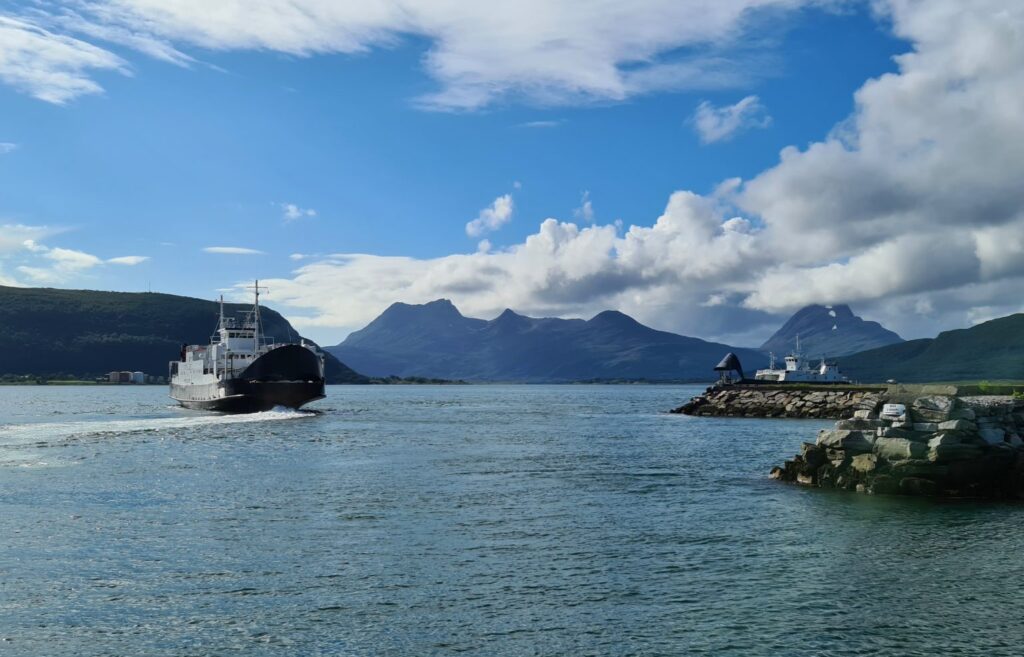
Payment
Most ferries are now fully automated. With an AutoPASS tag, payment is registered automatically. Rental cars usually add the cost to your bill later.
Cost
A car and driver typically cost 100–200 NOK, while motorhomes are charged more. The longer the ferry crossing, the higher the price. If price matters for your journey, always check before you go.
Routine
Drive onboard, pull the handbrake, and step outside to enjoy the fresh sea air and fjord views. Before arrival, drivers return to their vehicles.

Tips for taking ferries
- Check timetables, especially in the evenings and on Sundays.
- Expect queues in summer on popular routes – for example along the Helgeland coast in Northern Norway.
- Use the waiting time to grab a coffee or explore the small towns around the ferry dock.
- Treat the ferry ride as part of the experience – the views can be just as stunning as the drive itself.
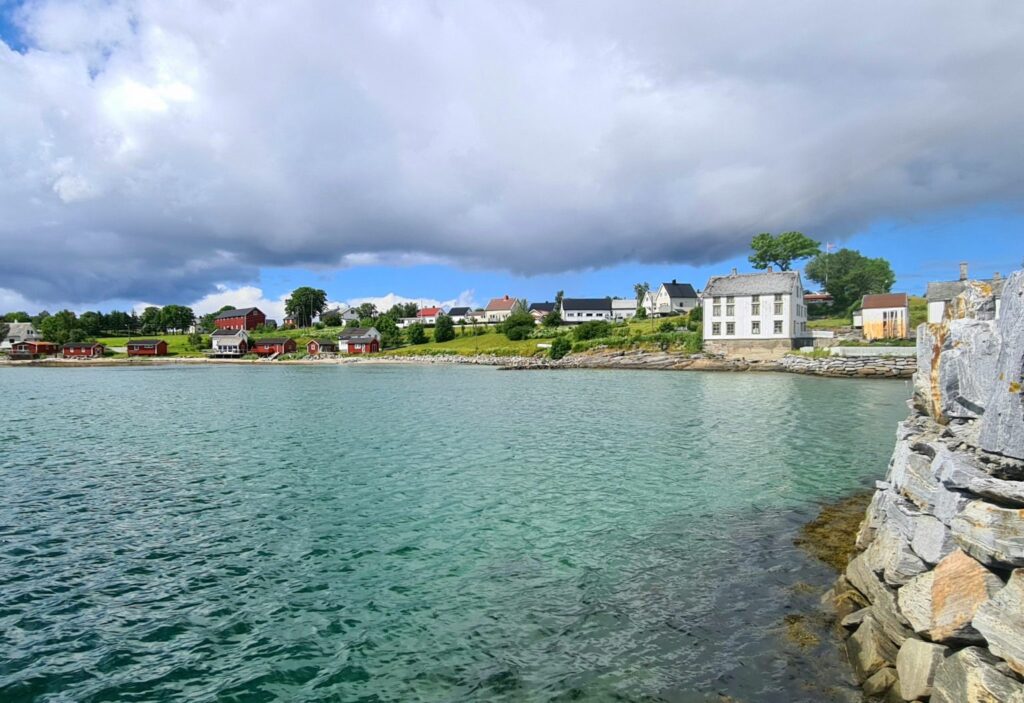
A greener way to travel
Norway is a world leader in electric ferries. Many crossings now use battery-powered vessels that glide almost silently across the fjords, reducing both noise and emissions. The shift to electric ferries is part of Norway’s big environmental push, so when you board one, you’re not only enjoying the scenery – you’re also traveling in one of the most eco-friendly ways possible.
Did you know? 🥞
On most Norwegian ferries you’ll find a tiny café – and the local specialty is the svele, a thick, fluffy pancake traditionally eaten with butter and sugar. For many Norwegians, it’s not a real ferry ride without one. Personally, I prefer the classic waffle with jam and sour cream – but you should try both and decide which becomes your ferry favorite.
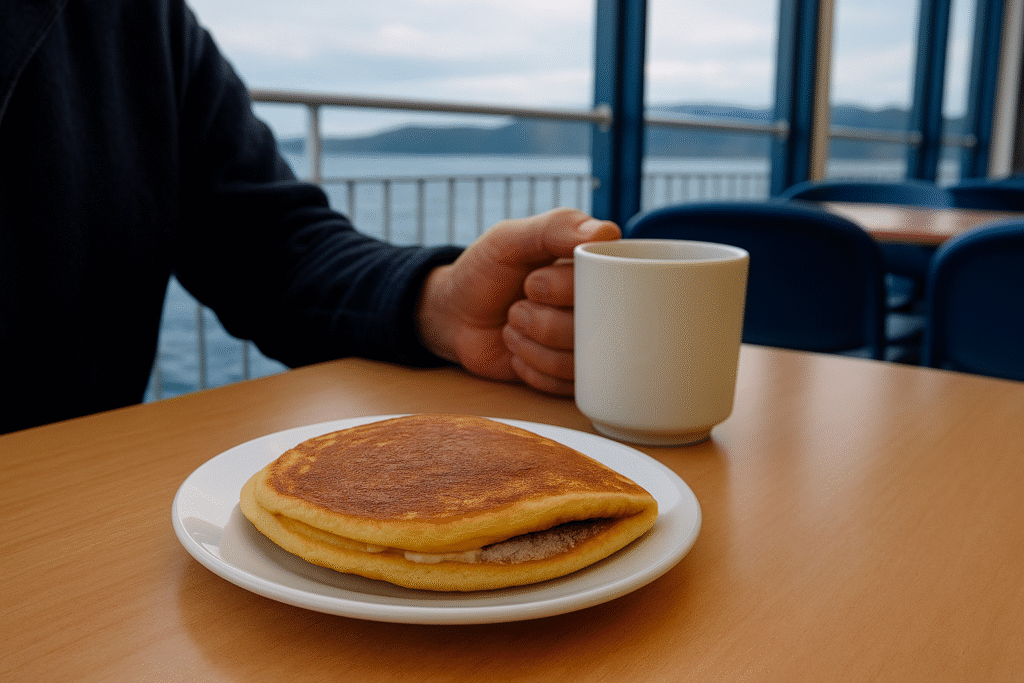
Costs and payments for driving in Norway
Tolls
Tolls are almost unavoidable in Norway. On motorways and many regional roads you’ll find automatic toll stations – there are no barriers and no need to stop. A camera simply reads your license plate as you drive through.
- AutoPASS system: Norwegians (and many frequent visitors) use an AutoPASS electronic tag linked to their account. For rental cars, the rental company usually takes care of tolls automatically and adds the charges to your bill afterwards.
- If you don’t have AutoPASS: Don’t worry – the system still registers your license plate. If you are driving your own car, the invoice will be sent to your home address abroad. This is handled by EPC (Euro Parking Collection).
💡 Tip for foreign drivers: If you’re bringing your own car, you can order an AutoPASS tag in advance via the AutoPASS/EPC website. It makes driving easier, ensures you always pay the lowest rate, and also covers many ferry crossings automatically.
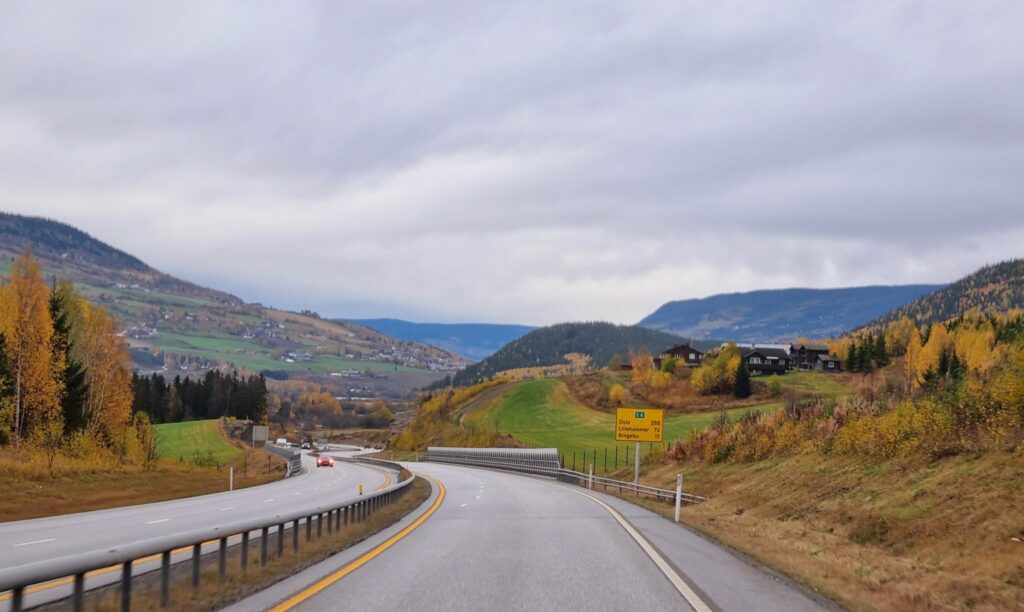
How to get an AutoPASS tag for your own car
If you’re bringing your own car or campervan to Norway, it’s smart to order an AutoPASS tag in advance. This makes it easier to pass toll stations, gives you the lowest rates, and also covers many ferry crossings automatically.
Here’s how:
- Go to the official AutoPASS page for foreign vehicles: autopass.no
- Register your vehicle and order a tag before your trip.
- The tag will be sent to your home address – attach it to your windshield.
- Link it to a payment account or card for automatic billing.
💡 With AutoPASS you don’t need to worry about unexpected bills arriving later – everything is handled automatically as you drive.
Ferry payments ⛴️
Many ferries are now integrated with the AutoPASS system. That means if you have an AutoPASS tag, your ferry cost is registered automatically when you drive on board. For rental cars, the charge is usually added to your invoice. If you don’t have AutoPASS, some ferries still allow card payment on board.
Useful ferry operators:
- Fjord1 – the largest ferry company in Western Norway
- Norled – ferries and express boats along the coast
- Torghatten Nord – ferries in Northern Norway
💡 Always check timetables in advance, especially on evenings and Sundays.
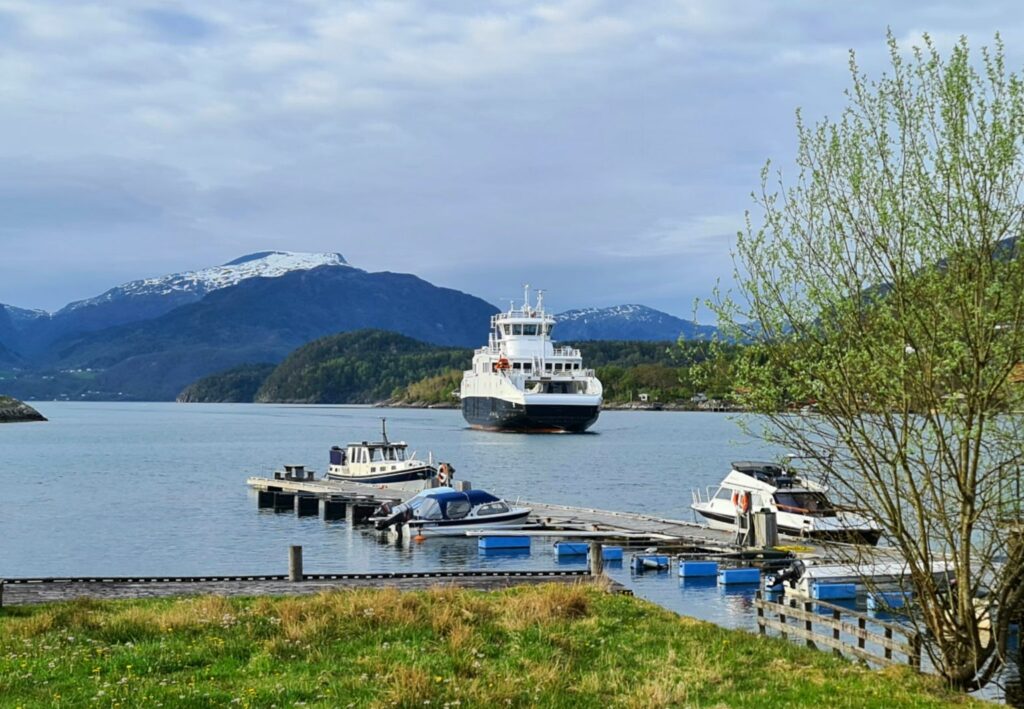
Fuel
Fuel prices in Norway are among the highest in Europe. Prices vary from place to place and can change by up to 2 NOK per liter during the day. Fuel is often cheaper outside city centers and on weekdays. It’s worth keeping an eye on the gauge and filling up before long rural stretches.
Charging electric cars
Norway is one of the easiest countries in the world to drive an electric car. Fast chargers are found along all main highways, and most small towns have at least one charging point. Prices vary depending on the operator – typically between 3 and 6 NOK per kWh. Apps like Recharge, Fortum, Ionity, or Mer are useful for finding and paying for charging. On long mountain routes, plan ahead to make sure a charger is available when you need it.
Parking
Parking can be limited and expensive in big cities like Oslo and Bergen. Download apps such as EasyPark to make it easier. Always follow the signs – outside the cities, parking is often free and more readily available.
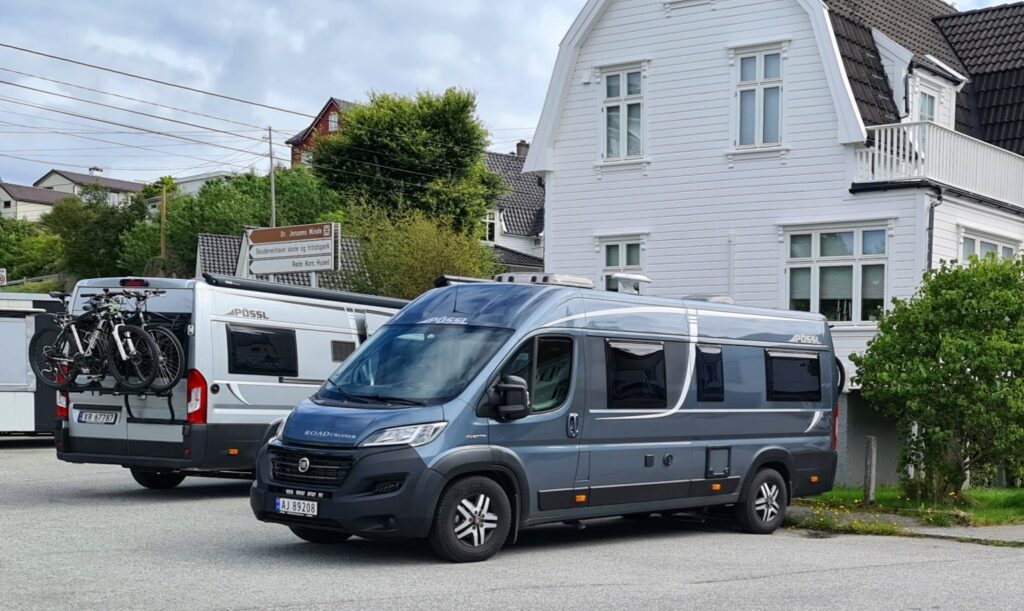
Did you know? 🏞️
Some of Norway’s most scenic drives are on narrow gravel roads through valleys and over mountain plateaus that are not part of the official highway system. These private roads often require tolls to stay open and maintained. Examples include Panoramavegen in Valdres, Grimsdalen near Dovre, and the Peer Gynt Road. They may cost a little extra and take more time – but the views are priceless and well worth the detour.

Motorhome travel and parking
Dedicated motorhome parking
Most towns in Norway have designated motorhome parking areas. They are often centrally located, with easy access to shops and attractions.
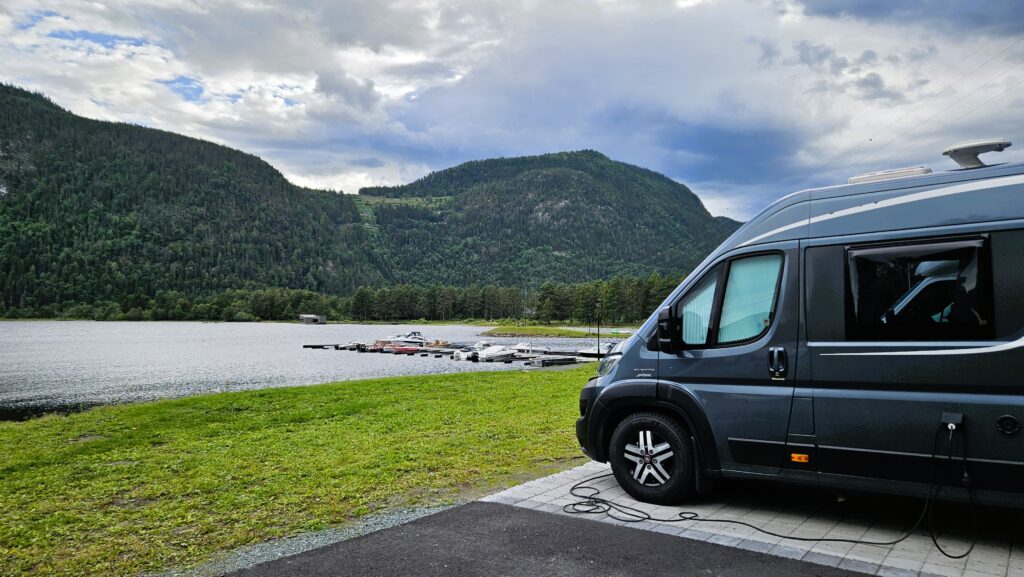
Campsites
There are more than 1,000 campsites in Norway, covering all price ranges and often located in beautiful surroundings, usually just outside towns and cities. In most cases you don’t need to book in advance, unless you arrive late or are visiting one of the most popular tourist areas in high season.
Tip: In popular destinations, especially in summer, it’s wise to arrive early in the afternoon to secure a spot. We personally use campsites or official motorhome parking areas most of the time – and we rarely book ahead unless we know we will be arriving late.

Free camping – the right to roam
Norway’s famous right to roam (allemannsretten) allows you to camp almost anywhere in nature. But remember: allemannsretten does not apply to vehicles.
You must park on a drivable road or a designated area – never drive into fields, meadows, or untouched nature. With this freedom comes responsibility: always keep a respectful distance from houses (at least 150 meters), and follow local signs where camping is restricted.
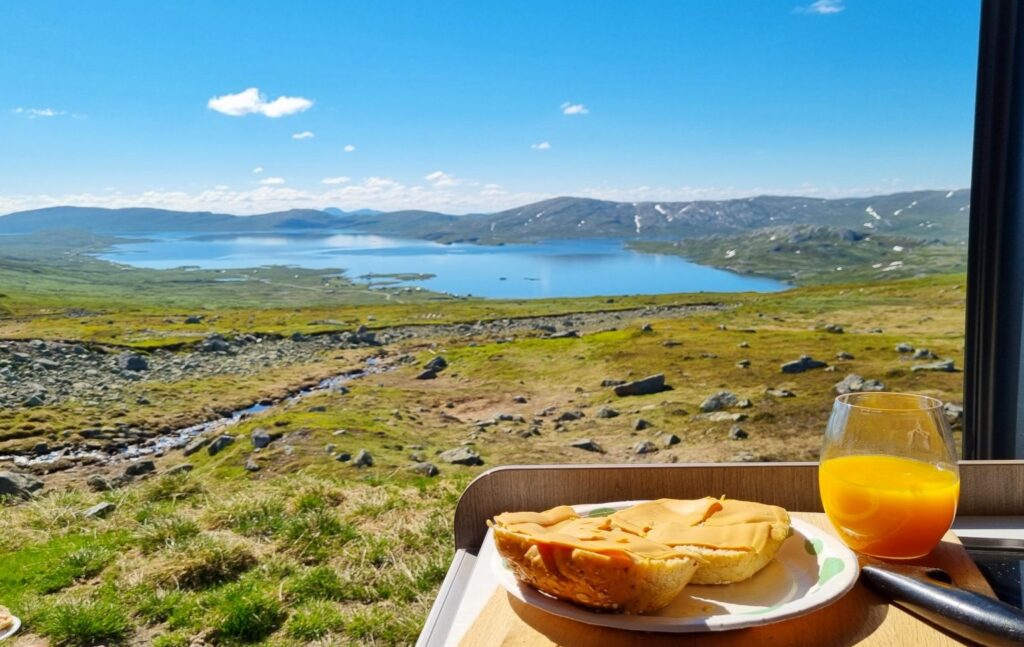
Unwritten rules for overnight parking – free camping
If you plan to spend the night outside regulated campsites or motorhome areas, follow these common guidelines:
- Be considerate of locals – don’t occupy places they normally use.
- Don’t park in local spots such as swimming areas, trailhead parking, churches, or cemeteries.
- Never block private driveways or farm fields – it’s both illegal and disrespectful.
- Be considerate of other campers – don’t spread out or take unnecessary space.
- Always take your rubbish with you and leave the spot cleaner than you found it.
- Don’t stay more than two nights in the same place.
- Never empty toilets or grey water in nature – every municipality has official disposal stations, and many fuel stations and campsites offer the same service.
- If your vehicle doesn’t have a toilet, bring a portable one or dig a proper hole far from trails, water sources, or houses.
- Keep noise levels down – for locals, this is home, not a campsite.
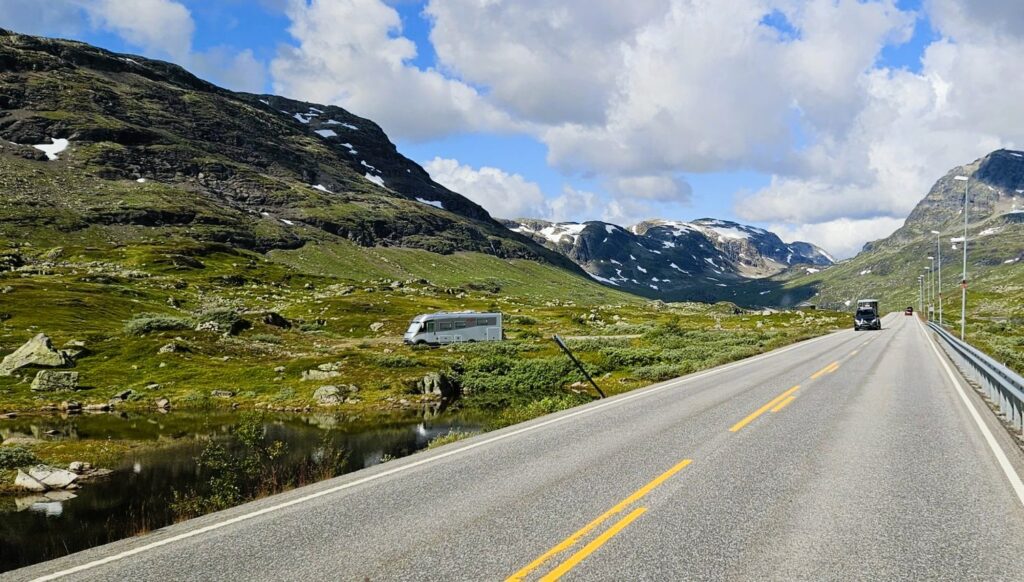
Respect the nature:
- Never use soap, shampoo, or detergents directly in rivers or lakes.(many lakes and rivers are used as drinking water sources).
- Avoid swimming near marked drinking water areas.
- Fires are only allowed in designated places and are often restricted between April and September due to forest fire risk.
- Stick to marked paths to avoid damaging vegetation.
- Fishing requires a license (fiskekort) in most rivers and lakes. These can be bought online at inatur.no, at local tourist offices, sports shops, or sometimes petrol stations.
Wild camping is not the same as Free camping
In Norwegian, wild camping means setting up camp where it is explicitly forbidden, while free camping means camping where it is not expressly prohibited. Many visitors confuse the two. Remember: just because you don’t see a “no camping” sign doesn’t mean it’s appropriate.
Did you know? 🏕️
Due to increasing problems with irresponsible wild camping in recent years, many municipalities have put up signs prohibiting overnight motorhome stays. And just because a spot appears in a motorhome app doesn’t mean it’s legal or acceptable. Use common sense, show respect – and always choose places that don’t cause inconvenience or embarrassment for others.
Local driving tips for Norway
- Always bring snacks and water – distances can be long, with few shops in between.
- Plan your fuel stops. Gas stations can be far apart in rural areas, so fill up before crossing mountain passes.
- Use rest stops when you see them – in remote areas, the next one might be hours away.
- Watch out for animals: sheep, reindeer, and elk can appear suddenly.
- Distances look short on the map, but winding roads mean drives take longer than expected.
- Weather can change quickly – always keep a jacket or an extra layer handy in the car.
- When entering tunnels, switch on your lights and take off sunglasses.
- Don’t rush – in Norway, the road is part of the adventure.
Did you know? 🦌
Elk and reindeer often wander onto the roads, especially at dusk. Collisions are rare, but always keep an eye out in forested and mountain areas.

Useful apps for driving in Norway
- Vegvesen Trafikk – live traffic updates, road closures, tunnel info.
- Fjord1 / Norled – ferry timetables.
- EasyPark – for parking in towns and cities.
Top 5 insider tips for driving in Norway
- Fill up before the mountains – gas stations can be far apart.
- Use rest stops when you see them – the next one might be hours away.
- Pull over to let locals pass – they’re often commuting, not sightseeing.
- Be ready for weather changes – always keep a jacket in the car.
- Treat tunnels with respect – lights on, sunglasses off.

Top 5 mistakes tourists make when driving in Norway 🚫
Mistakes you don’t have to make – if you’ve read this guide
- Stopping in unsafe places – never stop in the middle of the road to take photos. Wait for a lay-by.
- Ignoring speed limits – fines are high, and many roads are limited to 60–70 km/h even outside towns.
- Underestimating distances – a “two-hour drive” on the map can easily take double the time.
- Parking without respect – don’t block private driveways, fields, or local spots like swimming areas.
- Forgetting the weather – fog, rain, or even snow can appear suddenly, even in summer.
Narrow roads and meeting traffic
Norway’s scenic roads are beautiful, but many of them are also narrow and winding. Meeting oncoming traffic can be a challenge – especially when motorhomes or buses are involved. In some places, the road is so tight that vehicles must pull in their mirrors and hug the rock wall to make room.
The key is patience and cooperation. Norwegian drivers are used to these conditions, and with careful maneuvering and a calm pace, things usually work out fine. Take it slow, use passing pockets when available, and don’t be afraid to wait your turn. The reward is a safer drive – and often an even better view.
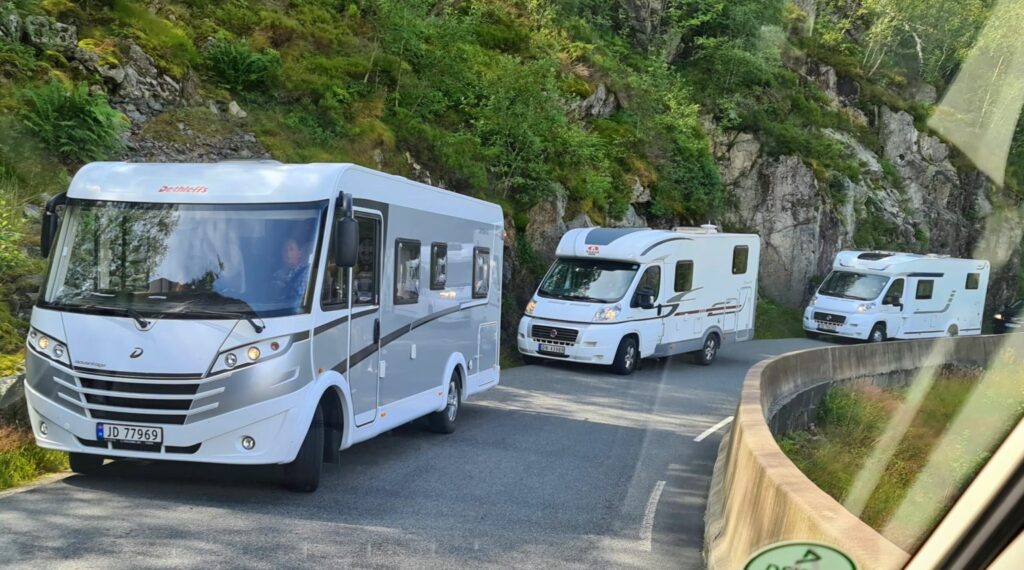
Plan smart, drive safe – and enjoy the magic of Norway’s roads
Driving in Norway is an unforgettable part of the travel experience. It’s not just about reaching your destination – it’s about what you see along the way. Every bend in the road might reveal a glacier, a sparkling fjord, or a tiny red cabin in the mountains. With some preparation, patience, and respect for local rules, driving in Norway becomes not just practical, but magical.
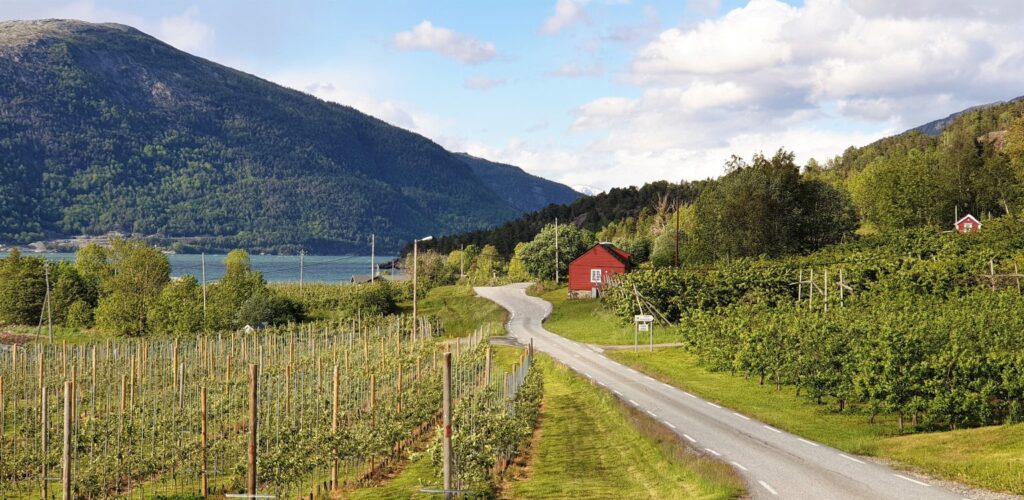
I wish you safe travels – and may your Norwegian road trip be filled with unforgettable moments – Anne Bente.

👉 Have you tried driving in Norway? Share your best tips and experiences in the comments – your advice might inspire the next traveler!





3 Comments
Pingback:
Pingback:
Pingback: